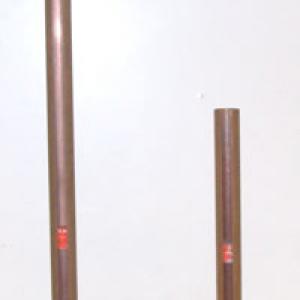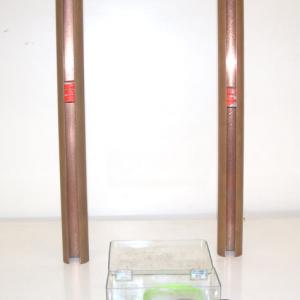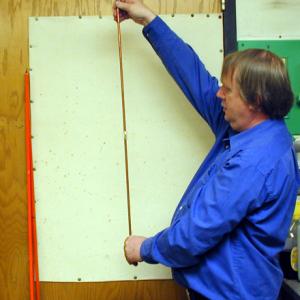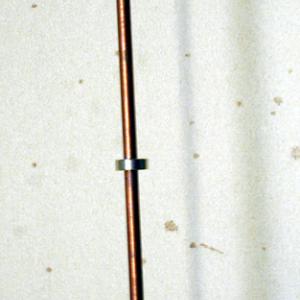College of Liberal Arts & Sciences
5K20.25 - Lenz's Law - Tubes and Magnets
Set the tube up so there is approximately 3" between the bottom of the tube and the drop pad. Drop any of the wood, copper, or aluminum slugs down the tube and show that there is no significant damping. The ceramic magnet will show some damping but will still drop quickly. Drop the neodymium magnet stack and observe that it takes up to 24 seconds for them to travel down the 1 meter tube and 12 seconds for the 1/2 meter tube.
The neodymium magnets now come in a ring version. These can be used with a copper rod to show eddy currents, and may be more visible than the tube and magnet version.
If you don't wish to use a tube with the slot cut into it you may use the copper and aluminum tubes that have the magnetic detecting film taped to them. You will be able to observe where the magnet is in the tube as the film will change color when influenced by the poles of the magnet stack.
- Sanjoy Kumar Pal, Soumen Sarkar, Pradipta Panchadhyayee, "A Smartphone-Based Simple Method for Determination of the Permeability of Free Space", TPT, Vol. 62, #6, Sept. 2024, p. 532.
- Robert Hobbs, "Adding a New Layer to a Favorite Demonstration: The Falling Magnet in a Conducting Tube", TPT, Vol. 61, #9, Dec. 2023, p. 727.
- Camila F. Marin Sepulveda, Juan C. Castro-Palacio, Isabel Salinas, Juan A. Monsoriu, "Acoustic Characterization of Magnetic Braking With a Smartphone", TPT, Vol. 60, #8, Nov. 2022, p. 706.
- F. Behroozi, "Rotation of Spherical Magnet Falling Through a Slit Copper Tube", TPT, Vol. 59, #4, April 2021, p. 243.
- Maarij Syed and N. Nuessle, "What a Metal Pipe Can Teach You About Magnetism", TPT, Vol. 57, #5, May 2019, p. 330.
- F. Behroozi, "Weighing a Magnet as it Falls with Terminal Velocity Through an Aluminum Pipe", TPT, Vol. 56, #7, Oct. 2018, p. 474.
- Shirish R. Pathare, Saurabhee Huli, Rohan Lahane, and Sumedh Sawant, "Low-Cost Timer to Measure the Terminal Velocity of a Magnet Falling Through a Conducting Pipe", TPT, Vol. 52, #3, Mar. 2014, p. 160.
- J. A. Molina-Bolivar and A. J. Abella-Palacios, "Magnetic Braking: A Video Analysis", TPT, Vol. 50, #7, Oct. 2012, p. 412.
- Petru S. Fodor and Tara Peppard, "Lenz's Law Demonstration Using an Ultrasound Position Sensor", TPT, Vol. 50, #6, Sept. 2012, p. 344.
- C. K. Lee and H. K. Wong, "Comments on 'Dramatic (and Simple!) Demonstration of Newton's Third Law'", TPT, Vol. 49, #7, Oct. 2011, p. 404.
- Gerald Feldman, "Dramatic (and Simple!) Demonstration of Newton's Third Law", TPT, Vol. 49, #2, Feb. 2011, p. 103.
- Michael J. Ruiz, "Lenz's Law Magic Trick", TPT, Vol. 44, #2, Feb. 2006, p. 96.
- Stephen Kanim and John R. Thompson, "Magnetic Field Viewing Cards", TPT, Vol. 43, #6, Sept. 2005, p. 355.
- Chang Geng Zhang and Shi Feng Hu, "Another Way to Demonstrate Lenz's Law", TPT, Vol. 40, #4, Apr. 2002, p. 249.
- Howard Brand, "Action-Reaction at a Distance", TPT, Vol. 40, #3, Mar. 2002, p. 136.
- Charles A. Sawicki, "A Lenz's Law Experiment Revisited", TPT, Vol. 38, #7, Oct. 2000, p. 439.
- O. Romulo Ochoa, Frank Kolp, and Joel T. Handler, "Quantitative Demonstration of Lenz's Law", TPT, Vol. 36, #1, Jan. 1998, p. 50.
- Thomas D. Rossing, "Eddy Currents and Magnetic Friction", TPT, Vol. 35, #3, Mar. 1997, p. 133.
- David Simmons and Robert Speers, "Magnetic Damping of a Mass-Spring Vertical Accelerometer", TPT, Vol. 35, #1, Jan. 1997, p. 49.
- Charles A. Sawicki, "A Dynamic Demonstration of Lenz's Law", TPT, Vol. 35, #1, Jan. 1997, p. 47.
- R. C. Nicklin, Andrew Graham, and Robert Miller, "Lenz's Law Demonstration for a Large Class", TPT, Vol. 35, #1, Jan. 1997, p. 46.
- Charles A. Sawicki, "Lenz's Law: Feel the Force", TPT, Vol. 34, #1, Jan. 1996, p. 38.
- Joseph Priest and Bryant Wade, "A Lenz Law Experiment", TPT, Vol. 30, #2, Feb. 1992, p. 106.
- Jhules A. M. Clack and Terrence P. Toepker, "Magnetic Induction Experiment", TPT, Vol. 28, #4, Apr. 1990, p. 236.
- Chang Hyeon Lee, Byung-Yoon Park, "A Magnet Falling Inside a Conducting Pipe: Dependence of the Drag Force on the Magnet Orientation", AJP, Vol. 91, #6, June 2023, p. 440.
- Guillermo Donoso, Celso L. Ladera, and Pablo Martin, "Damped Fall of Magnets Inside a Conducting Pipe", AJP, Vol. 79, #2, Feb. 2011, p. 193.
- M. K. Roy, Manoj K. Harbola, and H. C. Verma, "Demonstation of Lenz's Law: Analysis of a Magnet Falling Through a Conducting Tube", AJP, Vol. 75, #8, Aug. 2007, p. 728.
- Yan Levin, Fernando L. da Silveira, and Felipe B. Rizzato, "Electromagnetic Braking: A Simple Quantitative Model", AJP, Vol. 74, #9, Sept. 2006, p. 815.
- Scott M. Cohen, "Active Learning in Lectures Introducing Magnetic Induction", AJP, Vol. 73, #3, Mar. 2005, p. 284.
- John A. Pelesko, Michael Cesky, and Sharon Huertas, "Lenz's Law and Dimensional Analysis", AJP, Vol. 73, #1, Jan. 2005, p. 37.
- Kenneth D. Hahn et. al., "Eddy Current Damping of a Magnet Moving Through a Pipe", AJP, Vol. 66, #12, Dec. 1998, p. 1066.
- Cyrus S. MacLatchy, Philip Backman, Larry Bogan, "A Quantitative Magnetic Braking Experiment", AJP, Vol. 61, #12, Dec. 1993, p. 1096.
- "B-280. Pump Ring - Cow Magnet", DICK and RAE Physics Demo Notebook, 1993.
- Bob Devantery, "Lenz's Law in Slow Motion", PIRA Newsletter, Vol. 3, #8, Dec. 1988, p. 9.
- Robert Ehrlich, "N.5. Dropping a Magnet Down a Pipe", Turning the World Inside Out and 174 Other Simple Physics Demonstrations, p. 167 - 169.
- Tik L. Liem, "The Dropping Race", Invitations to Science Inquiry - Supplement to 1st and 2nd Ed. p. 84.
Disclaimer: These demonstrations are provided only for illustrative use by persons affiliated with The University of Iowa and only under the direction of a trained instructor or physicist. The University of Iowa is not responsible for demonstrations performed by those using their own equipment or who choose to use this reference material for their own purpose. The demonstrations included here are within the public domain and can be found in materials contained in libraries, bookstores, and through electronic sources. Performing all or any portion of any of these demonstrations, with or without revisions not depicted here entails inherent risks. These risks include, without limitation, bodily injury (and possibly death), including risks to health that may be temporary or permanent and that may exacerbate a pre-existing medical condition; and property loss or damage. Anyone performing any part of these demonstrations, even with revisions, knowingly and voluntarily assumes all risks associated with them.




